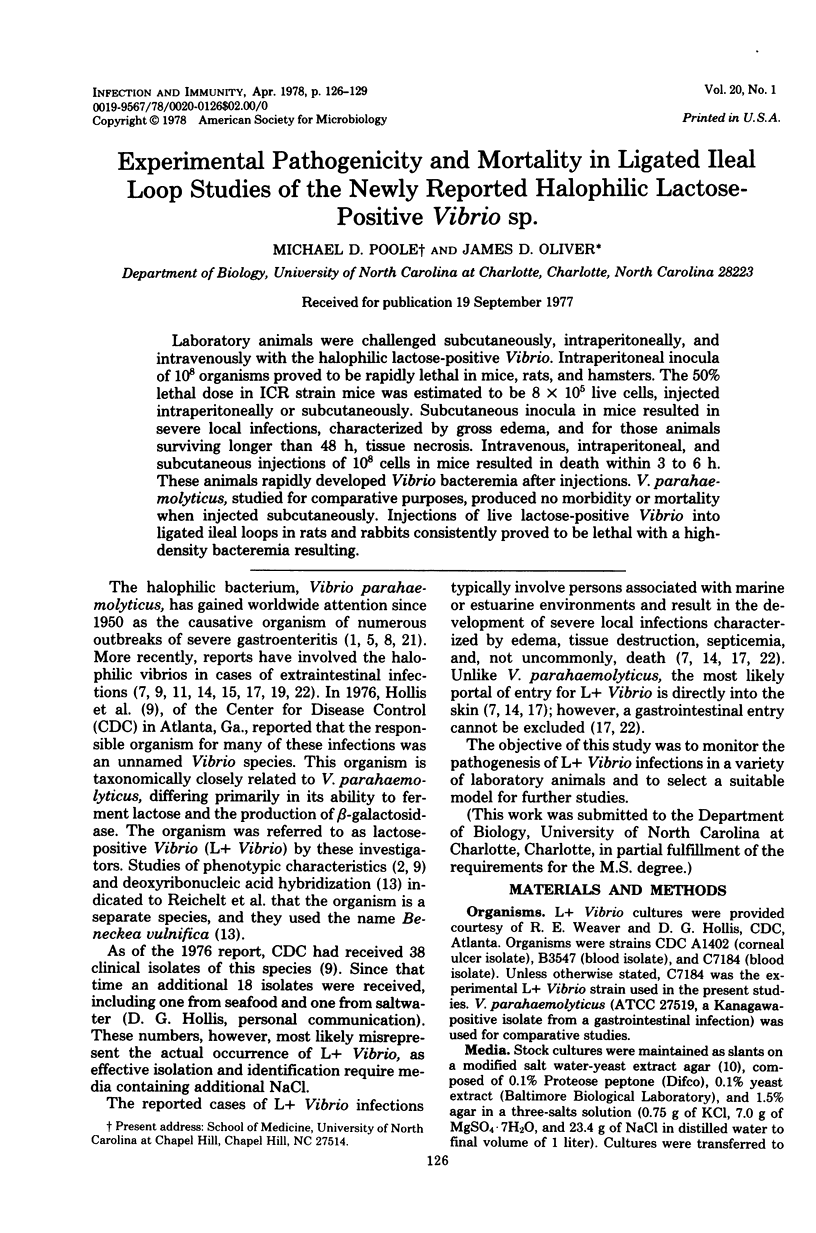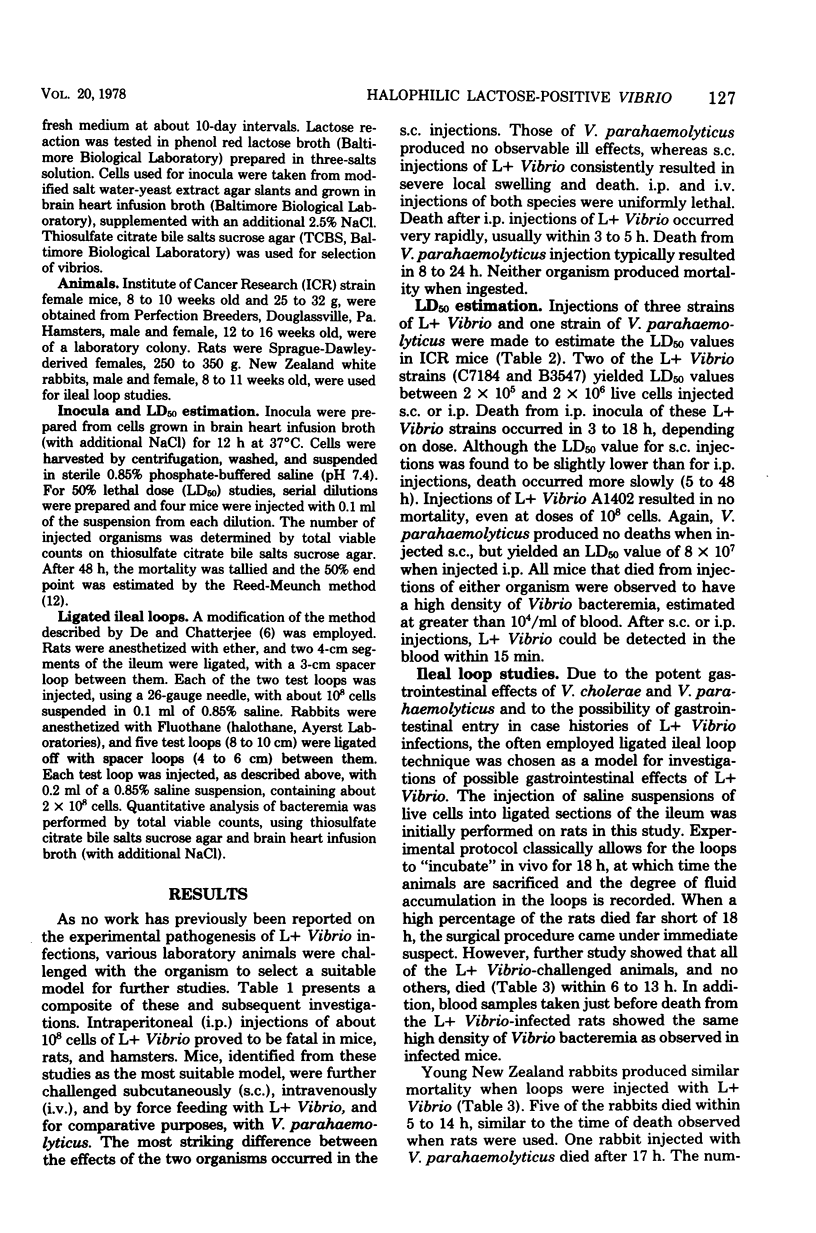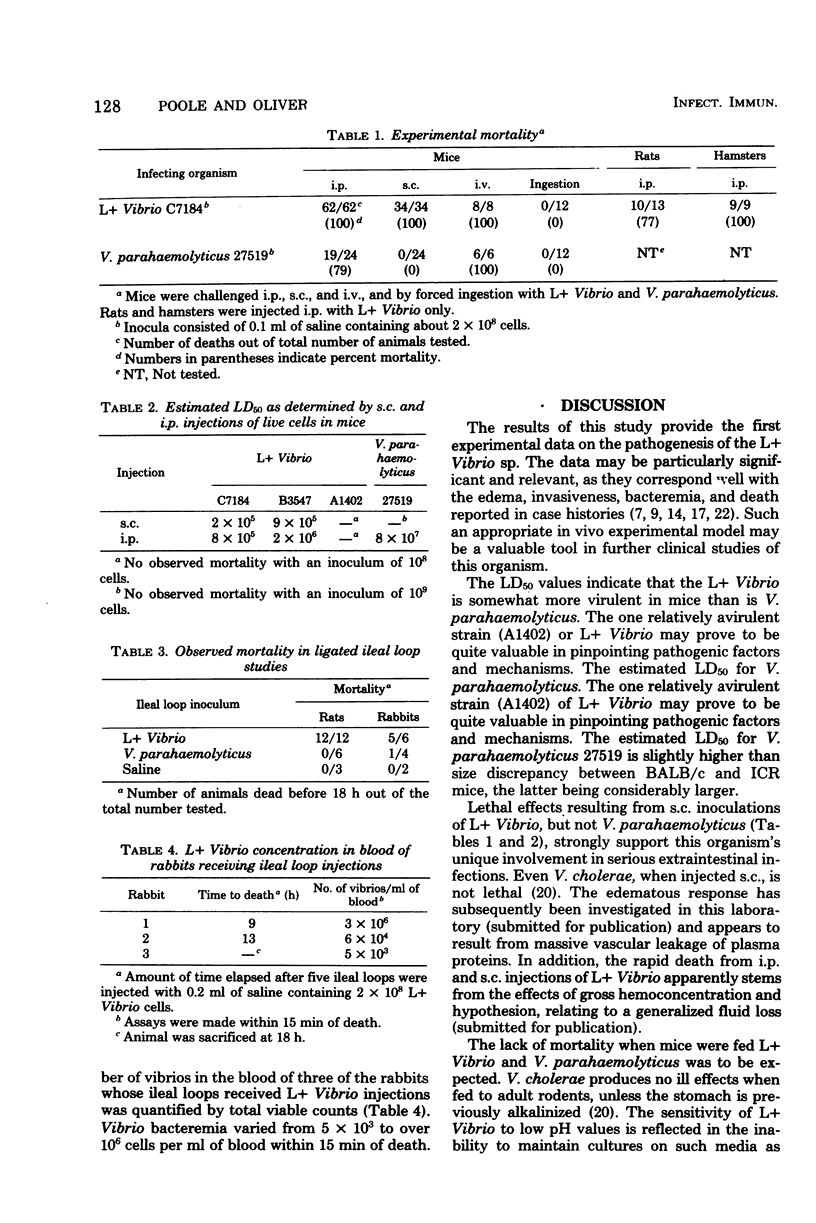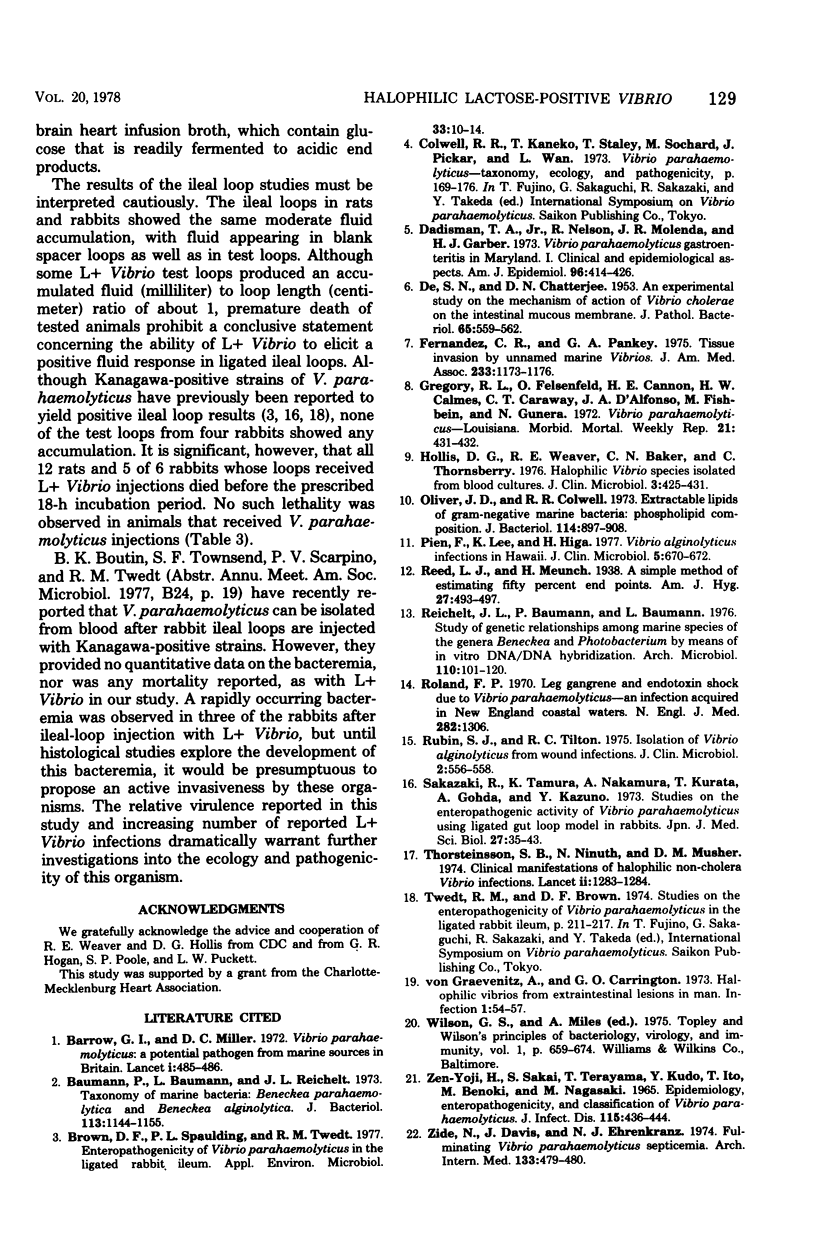Abstract
Laboratory animals were challenged subcutaneously, intraperitoneally, and intravenously with the halophilic lactose-positive Vibrio. Intraperitoneal inocula of 10(8) organisms proved to be rapidly lethal in mice, rats, and hamsters. The 50% lethal doese in ICR strain mice was estimatd to be 8 X 10(5) live cells, injected intraperitoneally or subcutaneously. Subtaneous inocula in mice resulted in severe local infections, characterized by gross edema, and for those animals surviving longer than 48 h, tissue necrosis. Intravenous, intraperitoneal, and subcutaneous injections of 10(8) cells in mice resulted in death within 3 to 6 h. These animals rapidly developed Vibrio bacteremia after injections. V. parahaemolyticus, studied for comparative purposes, produced no morbidity or mortality when injected subcutaneously. Injections of live lactose-positive Vibrio into ligated ileal loops in rats and rabbits consistently proved to be lethal with a high-density bacteremia resulting.
Full text
PDF



Selected References
These references are in PubMed. This may not be the complete list of references from this article.
- Barrow G. I., Miller D. C. Vibrio parahaemolyticus: a potential pathogen from marine sources in Britain. Lancet. 1972 Feb 26;1(7748):485–486. doi: 10.1016/s0140-6736(72)90134-1. [DOI] [PubMed] [Google Scholar]
- Baumann P., Baumann L., Reichelt J. L. Taxonomy of marine bacteria: Beneckea parahaemolytica and Beneckea alginolytica. J Bacteriol. 1973 Mar;113(3):1144–1155. doi: 10.1128/jb.113.3.1144-1155.1973. [DOI] [PMC free article] [PubMed] [Google Scholar]
- Brown D. F., Spaulding P. L., Twedt R. M. Enteropathogenicity of Vibrio parahaemolyticus in the ligated rabbit ileum. Appl Environ Microbiol. 1977 Jan;33(1):10–14. doi: 10.1128/aem.33.1.10-14.1977. [DOI] [PMC free article] [PubMed] [Google Scholar]
- Dadisman T. A., Jr, Nelson R., Molenda J. R., Garber H. J. Vibrio parahaemolyticus gastroenteritis in Maryland. I. Clinical and epidemiologic aspects. Am J Epidemiol. 1972 Dec;96(6):414–426. doi: 10.1093/oxfordjournals.aje.a121474. [DOI] [PubMed] [Google Scholar]
- FOY H., KONDI A. A case of true redcell aplastic anaemia successfully treated with riboflavin. J Pathol Bacteriol. 1953 Apr;65(2):559–564. doi: 10.1002/path.1700650228. [DOI] [PubMed] [Google Scholar]
- Fernandez C. R., Pankey G. A. Tissue invasion by unnamed marine vibrios. JAMA. 1975 Sep 15;233(11):1173–1176. [PubMed] [Google Scholar]
- Hollis D. G., Weaver R. E., Baker C. N., Thornsberry C. Halophilic Vibrio species isolated from blood cultures. J Clin Microbiol. 1976 Apr;3(4):425–431. doi: 10.1128/jcm.3.4.425-431.1976. [DOI] [PMC free article] [PubMed] [Google Scholar]
- Oliver J. D., Colwell R. R. Extractable lipids of gram-negative marine bacteria: phospholipid composition. J Bacteriol. 1973 Jun;114(3):897–908. doi: 10.1128/jb.114.3.897-908.1973. [DOI] [PMC free article] [PubMed] [Google Scholar]
- Pien F., Lee K., Higa H. Vibrio alginolyticus infections in Hawaii. J Clin Microbiol. 1977 Jun;5(6):670–672. doi: 10.1128/jcm.5.6.670-672.1977. [DOI] [PMC free article] [PubMed] [Google Scholar]
- Reichelt J. L., Baumann P., Baumann L. Study of genetic relationships among marine species of the genera Beneckea and Photobacterium by means of in vitro DNA/DNA hybridization. Arch Microbiol. 1976 Oct 11;110(1):101–120. doi: 10.1007/BF00416975. [DOI] [PubMed] [Google Scholar]
- Roland F. P. Leg gangrene and endotoxin shock due to vibrio parahaemolyticus--an infection acquired in New England coastal waters. N Engl J Med. 1970 Jun 4;282(23):1306–1306. doi: 10.1056/NEJM197006042822306. [DOI] [PubMed] [Google Scholar]
- Rubin S. J., Tilton R. C. Isolation of Vibrio alginolyticus from wound infections. J Clin Microbiol. 1975 Dec;2(6):556–558. doi: 10.1128/jcm.2.6.556-558.1975. [DOI] [PMC free article] [PubMed] [Google Scholar]
- Sakazaki R., Tamura K., Nakamura A., Kurata T., Goda A. Studies on enteropathogenic activity of Vibrio parahaemolyticus using ligated gut loop model in rabbits. Jpn J Med Sci Biol. 1974 Feb;27(1):35–43. doi: 10.7883/yoken1952.27.35. [DOI] [PubMed] [Google Scholar]
- Thorsteinsson S. B., Minuth J. N., Musher D. M. Clinical manifestations of halophilic non-cholera Vibrio infections. Lancet. 1974 Nov 30;2(7892):1283–1284. doi: 10.1016/s0140-6736(74)90141-x. [DOI] [PubMed] [Google Scholar]
- Zen-Yoji H., Sakai S., Terayama T., Kudo Y., Ito T., Benoki M., Nagasaki M. Epidemiology, enteropathogenicity, and classification of Vi.rio parahaemolyticus. J Infect Dis. 1965 Dec;115(5):436–444. doi: 10.1093/infdis/115.5.436. [DOI] [PubMed] [Google Scholar]
- Zide N., Davis J., Ehrenkranz N. J. Fulminating vibrio parahemolyticus septicemia. A syndrome of erythemia multiforme, hemolytic anemia, and hypotension. Arch Intern Med. 1974 Mar;133(3):479–481. doi: 10.1001/archinte.133.3.479. [DOI] [PubMed] [Google Scholar]
- von Graevenitz A., Carrington G. O. Halophilic vibrios from extraintestinal lesions in man. Infection. 1973;1(1):54–58. doi: 10.1007/BF01638258. [DOI] [PubMed] [Google Scholar]


